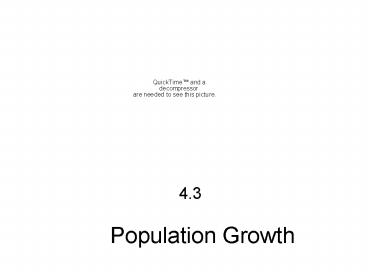Population Growth PowerPoint PPT Presentation
Title: Population Growth
1
Population Growth
- 4.3
2
Lesson 4.3 Population Growth
- From 1800 to today, the human population has
grown from about 1 billion to more than 6.8
billionan exponential rate of increase.
3
Birth and Death Rates
Lesson 4.3 Population Growth
- A populations relative birth and death rates
(mortality and natality) affect how it grows. - Survivorship curves show how the likelihood of
death varies with age.
4
Immigration and Emigration
Lesson 4.3 Population Growth
- In addition to births and deaths, population
growth is affected by immigration and
emigrationindividuals moving into and out of a
population. - Migration, seasonal movement into and out of an
area, can temporarily affect population size.
5
Calculating Population Growth
Lesson 4.3 Population Growth
- Determined by the following equation
(birthrate immigration rate) (death rate
emigration rate) - Growing populations have a positive growth rate
shrinking populations have a negative growth
rate. - Usually expressed in terms of individuals per 1000
6
Did You Know? Immigration contributes more than 1
million people to the U.S. population per year.
7
Exponential Growth
Lesson 4.3 Population Growth
- Population increases by a fixed percentage
every year. - Normally occurs only when small populations are
introduced to an area with ideal environmental
conditions - Rarely lasts long
8
(No Transcript)
9
Logistic Growth and Limiting Factors
Lesson 4.3 Population Growth
- Growth almost always slows and stops due to
limiting factors. - Limiting factors Environmental characteristics
slow population growth and determine carrying
capacity
10
- Density-dependent Influence changes with
population density. - Predation/Disease
- Density-independent Influence does not change
with population density. - Climate
11
Biotic Potential
Lesson 4.3 Population Growth
- An organisms maximum ability to produce
offspring in ideal conditions - Many factors influence biotic potential,
including gestation time and generation time.
12
Organisms with high biotic potential can recover
more quickly from population declines than
organisms with low biotic potential.
PowerShow.com is a leading presentation sharing website. It has millions of presentations already uploaded and available with 1,000s more being uploaded by its users every day. Whatever your area of interest, here you’ll be able to find and view presentations you’ll love and possibly download. And, best of all, it is completely free and easy to use.
You might even have a presentation you’d like to share with others. If so, just upload it to PowerShow.com. We’ll convert it to an HTML5 slideshow that includes all the media types you’ve already added: audio, video, music, pictures, animations and transition effects. Then you can share it with your target audience as well as PowerShow.com’s millions of monthly visitors. And, again, it’s all free.
About the Developers
PowerShow.com is brought to you by CrystalGraphics, the award-winning developer and market-leading publisher of rich-media enhancement products for presentations. Our product offerings include millions of PowerPoint templates, diagrams, animated 3D characters and more.

